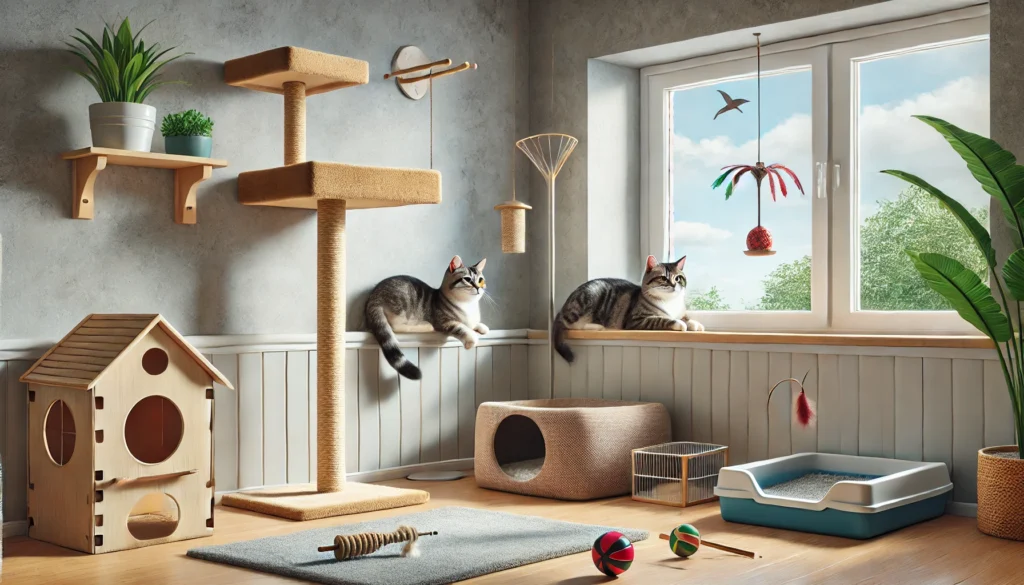Bringing an outdoor cat into an indoor-only lifestyle can be a rewarding but delicate process. While indoor living is generally safer—reducing the risk of injury, disease, and environmental dangers—it can be a big adjustment for cats used to roaming freely.
With patience, structure, and the right environment, you can help your cat enjoy a full and satisfying life indoors.
Understand the Challenges of the Transition
Outdoor cats are used to:
- Constant stimulation from smells, sights, and movement
- The freedom to explore, climb, and hunt
- Choosing their own routines and territories
When transitioning indoors, these freedoms are limited. Without the right preparation, your cat might show signs of stress like:
- Excessive meowing or pacing
- Scratching at doors or windows
- Trying to escape
- Increased anxiety or restlessness
Anticipating these challenges allows you to create a transition plan that eases them into the new lifestyle.
Start With a Gradual Adjustment (If Possible)
If your cat is still living outdoors, avoid an abrupt change.
- Begin by feeding them indoors at the same times each day
- Gradually increase their time inside after meals
- Create a predictable routine they can rely on
Over time, extend their indoor sessions until staying inside becomes normal.
Prepare a Safe, Stimulating Indoor Environment
Make the indoors just as appealing as the outdoors—with comfort and engagement.
- Provide multiple vertical spaces (cat trees, shelves, window perches)
- Add scratching posts, tunnels, and cozy beds
- Use puzzle feeders and toys that mimic prey movement
- Allow access to sunny windows for natural light and bird-watching
Variety in texture, scent, and height helps meet their sensory needs.
Use a Designated Transition Room First
Don’t give your cat full access to the house right away.
- Choose a quiet room with food, water, litter box, and a hiding space
- Let your cat explore and adjust at their own pace
- Gradually open up other areas of the home as they grow comfortable
This prevents overstimulation and helps them build confidence.
Keep the Litter Box Clean and Easy to Access
Outdoor cats are used to toileting in various areas, so switching to a litter box can be confusing.
- Use a large, uncovered box with low entry
- Choose unscented, soft-textured litter
- Scoop it daily and place it in a quiet, low-traffic area
Offer praise or treats when they use it correctly to reinforce the new habit.
Avoid Overhandling During the First Weeks
New environments can be overwhelming.
- Let your cat come to you for attention
- Avoid picking them up or forcing them to explore
- Offer treats or playtime as a form of trust-building
Respecting their space builds comfort and reduces fear.
Create a Window Watching Spot
Cats love to watch the outside world—even if they’re not in it.
- Install a perch or padded platform near a window
- Place a bird feeder outside (at a safe distance) to provide entertainment
- Keep windows secure with screens or barriers
This “TV for cats” can reduce boredom and fulfill natural curiosity.
Provide Enrichment to Replace Outdoor Stimulation
Indoor life doesn’t have to be boring.
- Rotate toys every few days to keep things fresh
- Hide treats for them to discover
- Offer different textures: cardboard, fleece, paper bags
- Use scent enrichment with catnip, silvervine, or lavender sachets
These tools satisfy your cat’s natural instincts in a safe environment.
Watch for Signs of Stress
Pay close attention during the first month of indoor life.
Signs of stress include:
- Hiding excessively
- Refusing to eat or use the litter box
- Aggression or excessive vocalizing
- Overgrooming or destructive scratching
If symptoms persist, consult a veterinarian or feline behaviorist.
Make It Permanent With Consistency and Love
Once your cat has fully transitioned:
- Stick to a routine for meals, play, and rest
- Avoid letting them back outdoors—this can undo the progress
- Continue offering enrichment and quiet spaces daily
With time, your cat will adjust to—and even prefer—the comfort and safety of indoor life.
Indoor living doesn’t mean limiting your cat—it means protecting them while giving them new ways to explore, rest, and thrive. With a gentle transition and the right tools, your former outdoor explorer will become a happy, healthy indoor companion.






